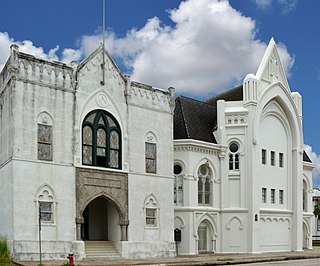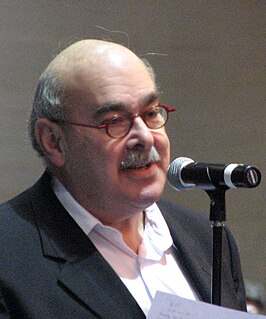The Texas Jewish Historical Society, (sometimes abbreviated TJHS), which began in 1980, is a society dedicated to the preservation of Jewish history in Texas.
The society was founded in 1980 by Rabbi Jimmy Kessler of Galveston. He published letters in Jewish newspapers in Houston, Dallas and Fort Worth, inviting people to participate in the creation of a historical society to preserve and appreciate Jewish history in Texas. [1] Today TJHS has about 800 members, who meet quarterly around the state. Membership is open to anyone who wants to "further the Society’s goals." [2]
In addition, as a result of increasing interest, the University of Texas has included the study of Texas Jewish history as one of its acknowledged fields, the first university to do so. This is part of a wider movement to study the history of Jewish life in the Americas since the several major European migrations to this region.
TJHS's website states that their purpose is to, "collect, preserve, publish and disseminate materials having reference to the settlement and history of Jews in Texas and their participation in its social, economic, religious, political, professional and cultural growth." Texas Jewish Historical Society The TJHS records are located at The Center for American History, part of the University of Texas at Austin. [3]
William E. Kaufman is an American Conservative rabbi, philosopher, theologian and author. His 1991 book, The Case for God, was perhaps the first book written on Jewish process theology.
Abraham Cohen Labatt was an American Sephardic Jew who was a prominent pioneer of Reform Judaism in the United States in the 19th century, founding several early congregations in the South and in San Francisco after the Gold Rush. A merchant, in the 1830s he helped pioneer trade between United States interests in Charleston and those in Texas and Mexico.
The history of Jews in Ohio dates back to 1817, when Joseph Jonas, a pioneer, came from England and made his home in Cincinnati. He drew after him a number of English Jews, who held Orthodox-style divine service for the first time in Ohio in 1819, and, as the community grew, organized themselves in 1824 into the first Jewish congregation of the Ohio Valley, the B'ne Israel. This English immigration was followed in the next two decades by the coming of German immigrants who, in contrast, were mostly Reform Jews. A Bavarian, Simson Thorman, settled in 1837 in Cleveland, then a considerable town, which thus became the second place in the state where Jews settled. Thorman was soon followed by countrymen of his, who in 1839 organized themselves into a congregation called the Israelitish Society. The same decade saw an influx of German Jews into Cincinnati, and these in 1841 founded the Bene Yeshurun congregation. To these two communities the Jewish history of Ohio was confined for the first half of the 19th century. In 1850 Ohio had six congregations: four in Cincinnati and two in Cleveland.

Congregation B'nai Israel is a Jewish synagogue located in Galveston, Texas, USA. Organized by German Jewish immigrants in 1868, it is the oldest Jewish Reform congregation and the second chartered Jewish congregation in the state.
Jewish Texans have been a part of the history of Texas since the first European explorers arrived in the region in the 16th century. In 1990, there were around 108,000 adherents to Judaism in Texas. More recent estimates place the number at around 120,000.

Henry Cohen was a British-American rabbi, scholar, community activist and writer who served most of his career at Congregation B'nai Israel in Galveston, Texas, from 1888 to 1949. He came to the United States in 1885, during a period of rapid and massive growth related to early 20th-century immigration from eastern and southern Europe. In Texas, he organized the Galveston Movement, which worked from 1907 to 1914 to attract eastern European Jewish immigrants to Galveston and the Gulf Coast as a destination, as an alternative to the better known Northeastern cities. Ten thousand such immigrants entered at Galveston.
The history of the Jews in Omaha, Nebraska, goes back to the mid-1850s.

James Lee Kessler, the founder of the Texas Jewish Historical Society, is the first native Texan to serve as rabbi of Congregation B'nai Israel in Galveston, Texas.

Congregation Beth Jacob is a Conservative Jewish synagogue located in Galveston, Texas. The present synagogue was built by Austrian, Russian and Hungarian immigrants in 1931.

Jews have inhabited the city of Galveston, Texas, for almost two centuries. The first known Jewish immigrant to the Galveston area was Jao de la Porta, who, along with his brother Morin, financed the first settlement by Europeans on Galveston Island in 1816. de la Porta was born in Portugal of Jewish parentage and later became a Jewish Texan trader. In 1818, Jean Laffite appointed de la Porta supercargo for the Karankawa Indian trade. When Laffite left Galveston Island in 1820, de la Porta became a full-time trader.
The history of the Jews in Brenham, Texas; covers a period of over 140 years. As one of the first areas in Texas, outside of major population centers, to develop a sizable Jewish population, the community boasts many things of historical note. The Brenham community was formally organized in 1885.
Dallas is the second-largest city in Texas and has one of the largest Jewish communities in the state.
David Lefkowitz, a rabbi, led Temple Emanu-El in Dallas, Texas from 1920 to 1949, after having worked at Temple Israel in Dayton, Ohio. He opposed the rise of the Ku Klux Klan, which had been revived in 1915; it was strongly opposed to immigrants who were Jews and Catholics from eastern and southern Europe. He was a Founding Executive Committee Member of the Dayton Branch of the National Association for the Advancement of Colored People (NAACP).

Temple Israel is a Reform congregation located at 130 Riverside Drive in Dayton, Ohio. Formed in 1850, it incorporated as "Kehillah Kodesh B'nai Yeshurun" in 1854. After meeting in rented quarters, the congregation purchased its first synagogue building, a former Baptist church at 4th and Jefferson, in 1863. Strongly influenced by Rabbi Isaac Mayer Wise, it rapidly modernized its services, and, in 1873, was a founding member of the Union for Reform Judaism.
Joseph Silverman, was a leading American Reform rabbi and author. He was the first American born rabbi to serve in New York City.

Temple Israel is a Reform Jewish congregation in Memphis, Tennessee, in the United States. It is the only Reform synagogue in Memphis, the oldest and largest Jewish congregation in Tennessee, and one of the largest Reform congregations in the U.S. It was founded in 1853 by mostly German Jews as Congregation B'nai Israel. Led initially by cantors, in 1858 it hired its first rabbi, Jacob Peres, and leased its first building, which it renovated and eventually purchased.

The Galveston Movement, also known as the Galveston Plan, was a U.S. immigration assistance program operated by several Jewish organizations between 1907 and 1914. The program worked to divert Jewish immigrants, fleeing Russia and eastern Europe, away from East Coast cities, particularly New York, which was already crowded with these poverty-stricken immigrants. During its operation, ten thousand Jewish immigrants passed through the port of Galveston, Texas, about a third the number that emigrated to Palestine during the same period. New York financier and philanthropist Jacob Schiff was the driving force behind the effort, which he supported with nearly $500,000 of his personal fortune. B'nai Israel's Rabbi Henry Cohen was the humanitarian face of the movement, meeting ships at the Galveston docks and helping guide the immigrants through the cumbersome arrival and distribution process, and on into the countryside.

The Jewish community of Houston, Texas has grown and thrived since the 1800s. As of 2008 Jews lived in many Houston neighborhoods and Meyerland is the center of the Jewish community in the area.
William Mordecai Kramer was an American rabbi, university professor and art collector. He served as the rabbi of Temple Beth Emet in Burbank, California from 1965 to 1996. He was an associate professor of religious studies at the California State University, Northridge for two decades, where he established the Jewish Studies program